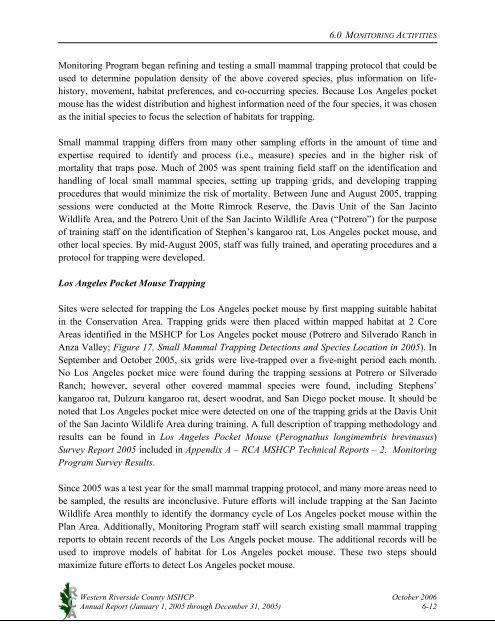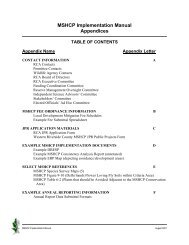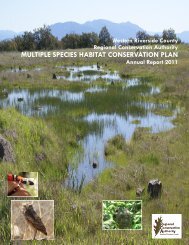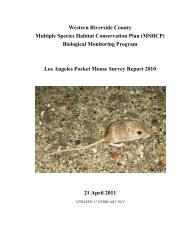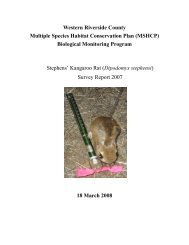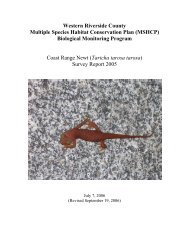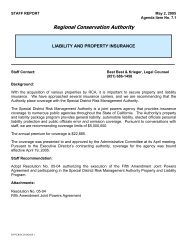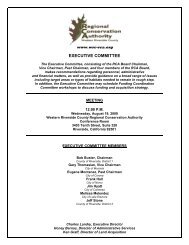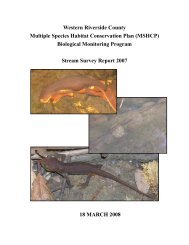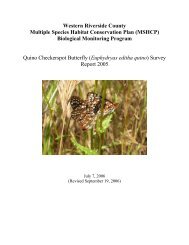Annual Report 2005 (62.7MB) - Western Riverside County Regional ...
Annual Report 2005 (62.7MB) - Western Riverside County Regional ...
Annual Report 2005 (62.7MB) - Western Riverside County Regional ...
- No tags were found...
You also want an ePaper? Increase the reach of your titles
YUMPU automatically turns print PDFs into web optimized ePapers that Google loves.
6.0 MONITORING ACTIVITIESMonitoring Program began refining and testing a small mammal trapping protocol that could beused to determine population density of the above covered species, plus information on lifehistory,movement, habitat preferences, and co-occurring species. Because Los Angeles pocketmouse has the widest distribution and highest information need of the four species, it was chosenas the initial species to focus the selection of habitats for trapping.Small mammal trapping differs from many other sampling efforts in the amount of time andexpertise required to identify and process (i.e., measure) species and in the higher risk ofmortality that traps pose. Much of <strong>2005</strong> was spent training field staff on the identification andhandling of local small mammal species, setting up trapping grids, and developing trappingprocedures that would minimize the risk of mortality. Between June and August <strong>2005</strong>, trappingsessions were conducted at the Motte Rimrock Reserve, the Davis Unit of the San JacintoWildlife Area, and the Potrero Unit of the San Jacinto Wildlife Area (“Potrero”) for the purposeof training staff on the identification of Stephen’s kangaroo rat, Los Angeles pocket mouse, andother local species. By mid-August <strong>2005</strong>, staff was fully trained, and operating procedures and aprotocol for trapping were developed.Los Angeles Pocket Mouse TrappingSites were selected for trapping the Los Angeles pocket mouse by first mapping suitable habitatin the Conservation Area. Trapping grids were then placed within mapped habitat at 2 CoreAreas identified in the MSHCP for Los Angeles pocket mouse (Potrero and Silverado Ranch inAnza Valley; Figure 17, Small Mammal Trapping Detections and Species Location in <strong>2005</strong>). InSeptember and October <strong>2005</strong>, six grids were live-trapped over a five-night period each month.No Los Angeles pocket mice were found during the trapping sessions at Potrero or SilveradoRanch; however, several other covered mammal species were found, including Stephens’kangaroo rat, Dulzura kangaroo rat, desert woodrat, and San Diego pocket mouse. It should benoted that Los Angeles pocket mice were detected on one of the trapping grids at the Davis Unitof the San Jacinto Wildlife Area during training. A full description of trapping methodology andresults can be found in Los Angeles Pocket Mouse (Perognathus longimembris brevinasus)Survey <strong>Report</strong> <strong>2005</strong> included in Appendix A – RCA MSHCP Technical <strong>Report</strong>s – 2. MonitoringProgram Survey Results.Since <strong>2005</strong> was a test year for the small mammal trapping protocol, and many more areas need tobe sampled, the results are inconclusive. Future efforts will include trapping at the San JacintoWildlife Area monthly to identify the dormancy cycle of Los Angeles pocket mouse within thePlan Area. Additionally, Monitoring Program staff will search existing small mammal trappingreports to obtain recent records of the Los Angels pocket mouse. The additional records will beused to improve models of habitat for Los Angeles pocket mouse. These two steps shouldmaximize future efforts to detect Los Angeles pocket mouse.<strong>Western</strong> <strong>Riverside</strong> <strong>County</strong> MSHCP October 2006<strong>Annual</strong> <strong>Report</strong> (January 1, <strong>2005</strong> through December 31, <strong>2005</strong>) 6-12


